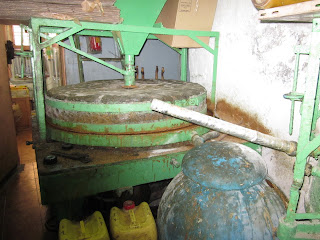Hope you all enjoy!
This week’s portion is Vayigash, when Joseph reveals to his brothers his true identity after so many years of separation. There are many different ways to look at this portion and today I want to look at the idea of brothers in the Torah and the evolution of a responsibility for others. Let’s take a brief run through of the brothers in Genesis; and the idea of a brother’s keeper. From Cain and Abel we see fratricide! The bar isn’t set exceptionally high to begin...Next let us look at Jacob and Eisaw, with fear of fratricide as Jacob runs for his life. Lastly we have the sons of Jacob who contemplate fratricide as the fate of their brother Joseph before ultimately deciding to sell him into slavery. This brings us to Vayigash and the dramatic switch in this chain of fraternal conflict.
The Torah shows us the magnitude of this transformation of brother relations through the connection of the word Vayigash. Vayigash, meaning approach, appears 7 times weeks earlier in the portion Toldot, the story of Jacob and Eisaw. While we read this week’s portion we are intended to think back to the story of Jacob and Eisaw and see the transformation into a different situation in which each brother is willing to sacrifice for the other. As Benjamin is being framed for thievery Judah makes a proclamation begging to take him instead, that losing Benjamin would be too painful for his father after he was the only remaining son of his favored wife Rachel.
וְעַתָּה יֵשֶׁב-נָא עַבְדְּךָ תַּחַת הַנַּעַר עֶבֶד לַאדֹנִי וְהַנַּעַר יַעַל עִם-אֶחָיו.
Please take me as a slave instead of Benjamin and let him return with his brothers.
This is big news in the Torah as it is the first time in our narrative that a brother has been willing to sacrifice his own life for another brother. Here Joseph makes the decision of peace due to his brother Judah’s actions as a response to an intimate test of t’shuva. Once revealing his true identity Joseph then explains how his role as an individual was God’s will for the sake of their family and to not dwell on their past together.
וְעַתָּה אַל-תֵּעָצְבוּ וְאַל-יִחַר בְּעֵינֵיכֶם כִּי-מְכַרְתֶּם אֹתִי הֵנָּה כִּי לְמִחְיָה שְׁלָחַנִי אֱלֹהִים
לִפְנֵיכֶם
Do not cause stress or frustrations on yourselves for selling me into slavery; it was to save life that God sent me ahead of you.
Jill Hammer, a Rabbi and faculty member of The Academy of Jewish Religion in Los Angeles says that: This new ability Judah has to empathize, to see the world from another’s point of view, is what convinces Joseph that the family is ready to have him as a member again. Finally, Joseph is able to say: “I am Joseph.” When each of us is willing to truly hear what another feels, we too allow the hidden to emerge. Joseph is hiding in plain site until he feels his brothers are ready to perceive him. By showing empathy and communal value we too make it possible for others to show their true person.
Rashi suggests a different concept completely, in that each brother would blame the others for having sold Joseph into slavery. Joseph, understanding how guilt manifests, anticipated his brothers' need to blame each other, and he therefore instructs them not to engage in such discourse about the past. Basically Joseph tells his brothers that their actions were not in their control and they cannot change what happened rather simply now live in the present despite their past for a positive future.
These two pieces of advice are no less accurate in today’s world. To give others the ability to know our feelings provides a platform for better social interactions and communal responsibility for the wellbeing of everyone. This pairs very well with the notion which Rashi eludes to of moving forward, disregarding the small problems which only create drama and focusing on something greater. Ridding ourselves of petty jealousy and unhealthy competition, allows us to embrace teamwork and communal responsibility. I see these points especially valid when I consider the journey of my own community in Jerusalem as first year students with HUC. The values which are strongest in this community are integrity and social responsibility, helping each other to progress as chevruta in and out of classes to become qualified Jewish leaders. Unlike the brothers before, in this week’s portion there there is no benefit to climbing over other students. There is no real importance to what class level you are in, who wrote your recommendation letters, or how often you alone achieve success. What matters is the process of communal growth and achievements of many. For example any one student passing their big midterm is the means to the more important outcome of the collaborative effort of a group of students working together in preparation for the exam to ensure success as a kehillah (community). Exactly like Judah makes evident in his willing sacrifice for Benjamin, understanding Benjamin's importance to his father; each student brings about different resources to help the community grow.
Joseph and his brothers shared a moment that made their bumpy and dark past obsolete. The importance of a family and support system was reinstated immediately and provides the Jewish People with a context of how to understand and value the role of family. Each moment is never as important as the big picture; at HUC the goal is establishing a cohort of future leaders, not simply the completion of an individual's ordination. Much like Hillel's concept of the candles growing in number and intensity each night, we too will shine brightest together.








